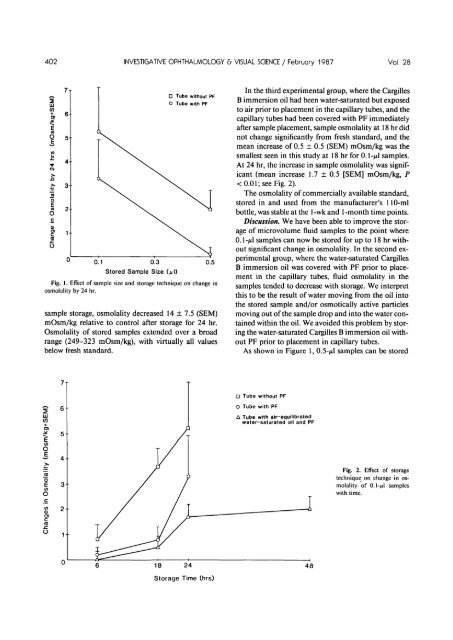Improved Technique For Storoge of Teor Microvolumes
Improved Technique For Storoge of Teor Microvolumes
Improved Technique For Storoge of Teor Microvolumes
Create successful ePaper yourself
Turn your PDF publications into a flip-book with our unique Google optimized e-Paper software.
402 INVESTIGATIVE OPHTHALMOLOGY & VISUAL SCIENCE / Februory 1987 Vol. 28<br />
2<br />
UJ<br />
w +<br />
E eo<br />
O<br />
E<br />
> 3<br />
a<br />
o<br />
E<br />
CO<br />
O<br />
Q)<br />
CD<br />
C<br />
«<br />
0.1 0.3<br />
Stored Sample Size (yl)<br />
0 Tube without PF<br />
O Tube with PF<br />
Fig. 1. Effect <strong>of</strong> sample size and storage technique on change in<br />
osmolality by 24 hr.<br />
sample storage, osmolality decreased 14 ± 7.5 (SEM)<br />
mOsm/kg relative to control after storage for 24 hr.<br />
Osmolality <strong>of</strong> stored samples extended over a broad<br />
range (249-323 mOsm/kg), with virtually all values<br />
below fresh standard.<br />
0.5<br />
In the third experimental group, where the Cargilles<br />
B immersion oil had been water-saturated but exposed<br />
to air prior to placement in the capillary tubes, and the<br />
capillary tubes had been covered with PF immediately<br />
after sample placement, sample osmolality at 18 hr did<br />
not change significantly from fresh standard, and the<br />
mean increase <strong>of</strong> 0.5 ± 0.5 (SEM) mOsm/kg was the<br />
smallest seen in this study at 18 hr for 0.1-^1 samples.<br />
At 24 hr, the increase in sample osmolality was significant<br />
(mean increase 1.7 ± 0.5 [SEM] mOsm/kg, P<br />
< 0.01; see Fig. 2).<br />
The osmolality <strong>of</strong> commercially available standard,<br />
stored in and used from the manufacturer's 110-ml<br />
bottle, was stable at the 1-wk and 1-month time points.<br />
Discussion. We have been able to improve the storage<br />
<strong>of</strong> microvolume fluid samples to the point where<br />
0. \-n\ samples can now be stored for up to 18 hr without<br />
significant change in osmolality. In the second experimental<br />
group, where the water-saturated Cargilles<br />
B immersion oil was covered with PF prior to placement<br />
in the capillary tubes, fluid osmolality in the<br />
samples tended to decrease with storage. We interpret<br />
this to be the result <strong>of</strong> water moving from the oil into<br />
the stored sample and/or osmotically active particles<br />
moving out <strong>of</strong> the sample drop and into the water contained<br />
within the oil. We avoided this problem by storing<br />
the water-saturated Cargilles B immersion oil without<br />
PF prior to placement in capillary tubes.<br />
As shown in Figure 1, 0.5-/*l samples can be stored<br />
LLJ<br />
CO<br />
7 T<br />
6 +<br />
D Tube without PF<br />
O Tube with PF<br />
A Tube with air-equilibrated<br />
water-saturated oil and PF<br />
to<br />
o<br />
E<br />
(A<br />
O<br />
5<br />
E<br />
O<br />
£ 4<br />
3<br />
Fig. 2. Effect <strong>of</strong> storage<br />
technique on change in osmolality<br />
<strong>of</strong> O.\-fi\ samples<br />
with time.<br />
CO<br />
0)<br />
O)<br />
c<br />
co<br />
sz<br />
O<br />
2<br />
1 ••<br />
18 24<br />
Storage Time (hrs)<br />
48
















